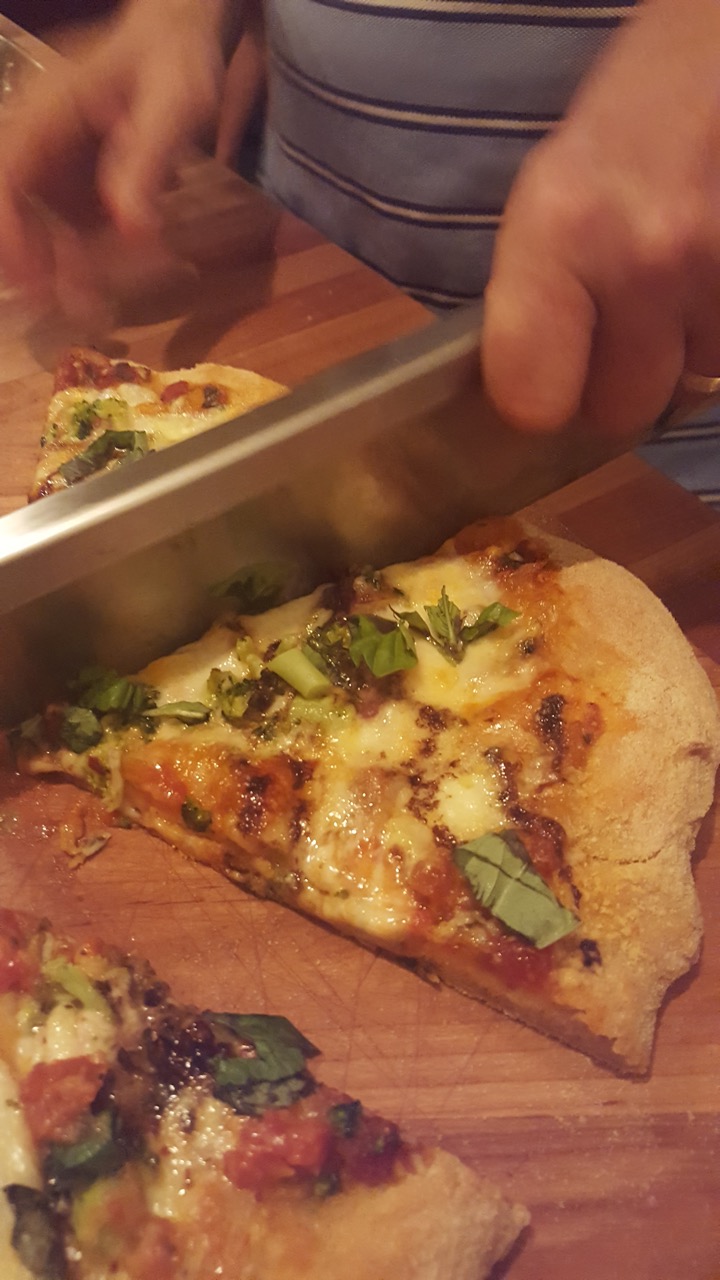One of my family’s favorite dishes is homemade pizza. Making pizza connects me to my Italian heritage, and I find satisfaction in creating this rustic, healthful food. My kids, of course, love the result.
Making pizza from scratch takes a bit of time, but not as much as you might think. I enjoy the entire process, beginning with grinding the whole grains into fresh flour. My favorite flours are made from Kamut and farro; to enhance the elasticity of the dough, I add a bit of gluten flour. The result is a satisfyingly chewy crust.
The toppings are limited only by your imagination. We enjoy a variety of organic fresh vegetables, good quality cheeses, mushrooms (including wild mushrooms), and herbs. Although it’s not usually our main course, we often enjoy pizza in place of bread. A slice or two of pizza fresh from the oven is a delicious accompaniment to soups, salads, grilled fish, or roasted vegetables. If there’s any pizza left over, it makes a great lunch or snack.
Authentic Homemade Pizza
The key to a really great pizza is the crust. I find kneading the dough to be a relaxing, almost meditative activity. To save time on busy days, the dough can be made ahead and stored in the refrigerator for 1-2 days before baking.
I use a pizza stone for baking pizza—the unglazed clay surface absorbs and distributes heat evenly, essentially transforming a regular oven into a pizza oven. Preheating the pizza stone is the key to creating a crisp crust. Preheat the pizza stone in the oven for 30 minutes and make sure that your pizza dough is at room temperature before baking to avoid cracking the pizza stone. A pizza peel (a long-handled wide, flat wooden paddle) makes it easy to transfer the pizza crust to a hot oven.
Making the crust: (makes 2-3 thin crusts)
- 2 ¼ cups warm water
- 1 tablespoon honey
- 1 tablespoon olive oil
- 2 teaspoons sea salt
- 1 tablespoon active dry yeast
- 4-5 cups kamut or farro flour
- 1 tablespoon gluten flour
- In a large bowl, combine warm water with honey, olive oil, and salt. Stir in yeast and let stand about 5 minutes.
- Add Kamut or farro flour (fresh ground, if possible), and 1 tablespoon of gluten flour. Stir in 3 cups of flour and mix well. Continue adding flour (a little at a time) while mixing with your hands until the dough pulls away from the bowl. (You can substitute 1 cup of organic unbleached white flour for one cup of the Kamut/farro flour if desired to help with texture and workability, but it’s not necessary.)
- Turn the dough out onto a lightly floured work surface and knead for 5-7 minutes, adding enough additional flour as necessary to form a smooth, elastic dough.
- Transfer the dough to a large bowl lightly oiled with olive oil, and turn the dough so that it’s oiled. Cover with a clean, damp kitchen towel and let rise in a warm place until doubled in size, about 1 and ½ hours.
- Punch down dough and divide into 2-3 evenly sized balls. Cover with a damp towel and let the dough rest for about 15 minutes. (To store the dough, place in an airtight container in the refrigerator.)
Making the pizza:
- Preheat the oven to 475 degrees F; if you have a pizza stone, place it on the bottom rack of the oven.
- To prepare the pizza, place the dough on a lightly floured surface. Shape as desired and roll out the dough to a thickness of about ¼ inch, starting in the center of the dough and working out toward the edges.
- Brush the crust with olive oil. Transfer the dough to the preheated pizza stone (a pizza peel makes it easy) and bake for a couple of minutes.
- Remove from oven with a wide metal spatula and add toppings (see below); bake another few minutes until crust is crisp and golden and toppings are cooked to your liking.
- Remove from oven and serve immediately.
- Add a thin layer of cheese. One of my favorites is fresh buffalo mozzarella, a soft delicate cheese from southern Italy. Other good choices include provolone, chevre and Parmegiano-Reggiano.
- Add vegetable toppings. I often add a thin layer of fresh spinach topped with lightly sautéed vegetables. Our family particularly enjoys caramelized onions, with garlic and a variety of mushrooms. Thinly sliced broccoli, red or orange bell peppers, or any other favorite vegetables can be added to the caramelized onions. Add salt, pepper, and fresh or dried herbs (oregano, parsley, sage, thyme) to the vegetable mixture while sautéing.
- Drizzle a bit of balsamic vinegar over the pizza, sprinkle with a few red pepper flakes, and bake.
- When the pizza comes out of the oven, I like to garnish it with a liberal sprinkling of julienned fresh basil when it’s in season.
Of course, you can also simply make a classic margherita pizza, with tomatoes, basil and mozzarella. Whatever kind you make, share it with family and friends, and enjoy!


